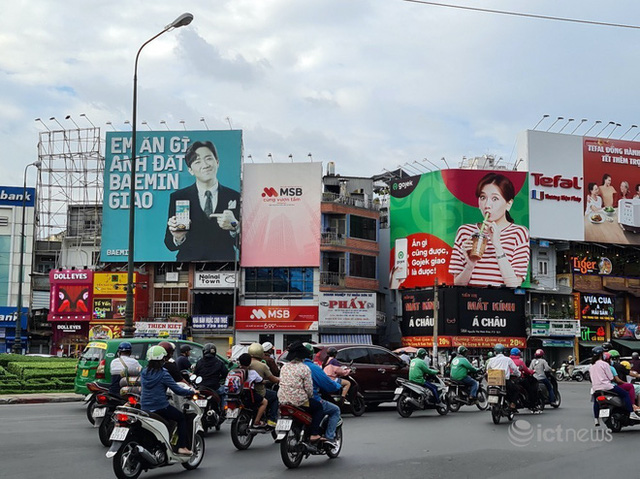The truth about Baemin “rocky” Gojek billboards in Saigon
- Tram Ho
On social networks recently appeared an image of a billboard of Gojek next to Baemin, with content showing that the Indonesian car company “kicked” the application from Korea. The photo looks like a edited product but is real in Ho Chi Minh City.

Gojek’s billboard was placed next to Baemin’s ad on the streets of Saigon. (Photo: Hai Dang)
Right at a busy traffic circle in the middle of Saigon, there was an ad with the picture of Tran Thanh using the Baemin app, under which there was the words: “What do you eat, I ordered Beamin to deliver?”.
The story will be nothing if there is no advertisement next to Gojek: “Whatever you eat, Gojek can deliver”, using the prominent image of Hari Won – Tran Thanh’s wife.
It seems that Gojek’s advertisement is also in a number of other locations, next to Baemin’s board.
This image is transmitted in many groups of drivers and technology groups working on media and advertising. Many comments have been raised, of which mainly curiosity, curiosity and surprise about the image of two billboards standing side by side.
Gojek and Baemin’s media department did not comment on the issue when asked by ICTnews.
Communications expert Nguyen Ngoc Long (Media Founder Black Moon) said “excited” about the above story, and appreciated the creativity of the marketing team Gojek. “But I wonder if backstage, the people involved will have any problems with partners or not,” Mr. Long answered ICTnews.
Previously, there was a similar response of two brands in Vietnam specializing in nutritional beverage products for children, receiving many highly appreciated comments on advertising expertise.
In the technology world, Samsung used to have video “kicking” Oppo in Vietnam, but then the controversial clip was cut, leaving only the advertising product.
Regarding Gojek’s advertising, Huynh Le Khanh, Senior CEO, Golden Communication Group, said that in this story there are not any points that violate the fundamental values of Vietnamese culture. Generally speaking.
The message, the way of expressing the message and the way in which the message is placed in the public place remains consistent with Vietnamese culture overall.
“Only one aspect is the culture of direct communication. Asians in general and Vietnamese people in particular are often unfamiliar with direct culture, so when looking at the “direct response” of these two brands, many people may feel something “overwhelming. “.
However, in terms of career, these “responses” are really interesting for those who are working in the advertising industry “, Mr. Khanh analyzed.
Agreeing with the above point of view, Mr. Long said that two billboards placed separately and stood next to each other did not violate any cultural values. On the contrary, this way of advertising attracts the attention of passers-by, and is compelling enough to generate discussions on both mainstream and social media, naturally and for free.
Mr. Khanh also said that the two billboards are effective when drawing attention. But if you are concerned with other goals such as receiving user messages, understanding, finding more information, trusting and using it, it needs a specific survey to evaluate the level of contribution. this advertising template for the brand after the campaign.
The above-mentioned advertising screens are not strange in the world. Pepsi and Coca Cola used to have ads “kicked” each other that inspired both users and professionals. Or Apple and Microsoft used to have many interesting videos “crossed”.
Source : Genk
